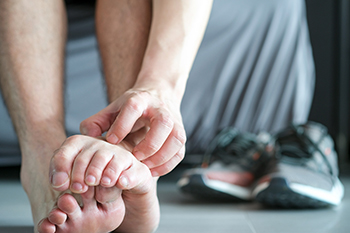Most runners experience injuries from time to time, and pushing the body too far is probably the most common cause of foot and ankle injuries. Stress fractures and heel pain can also be caused by inefficient running habits. Increasing your cadence slowly, (the number of steps per minute) can help to prevent injury. An efficient running cadence is thought to be between 85 and 100 steps per minute, counting on one leg. Anything under 75 may increase your chances of injury. Another way to avoid injury is to reduce the amount of time your feet are on the ground while running. A third suggestion is to slightly lean into the run and let gravity help propel you forward. These changes can help to reduce the impact that causes stress on the bones and muscles. If you are experiencing foot or heel pain while or after running, please see a podiatrist as soon as possible for a diagnosis and treatment plan before continuing activity.
Exercising your feet regularly with the proper foot wear is a great way to prevent injuries. If you have any concerns about your feet, contact one of our podiatrists of Biebel & DeCotiis Podiatry Associates. Our doctors will treat your foot and ankle needs.
How to Prevent Running Injuries
Many common running injuries are caused by overuse and overtraining. When the back of the kneecap starts wearing out and starts causing pain in your knee, this is commonly referred to as runner’s knee. Runner’s knee is a decrease in strength in your quadriceps and can occur if you’re not wearing properly fitted or supporting shoes. To prevent runner’s knee, focusing on hip strengthening is a good idea, as well as strengthening your quads to keep the kneecaps aligned.
What Are Some Causes of Running Injuries?
- One cause of a common running injury is called iliotibial band syndrome.
- Plantar fasciitis is also another common injury.
- Stress fractures can occur from overtraining, lack of calcium, or even your running style.
Best Ways to Prevent Running Injuries
- Wear footwear that fits properly and suits your running needs.
- Running shoes are the only protective gear that runners have to safeguard them from injury.
- Make a training schedule. Adding strengthening exercises as well as regular stretching can help keep you strong and limber and can lessen the possibility of injuries.
- Stretching keeps muscles limber; this will help you gain better flexibility.
If you have any questions please feel free to contact one of our offices located in Holmdel and Middletown, NJ . We offer the newest diagnostic and treatment technologies for all your foot and ankle needs.






 Bunions
Bunions


